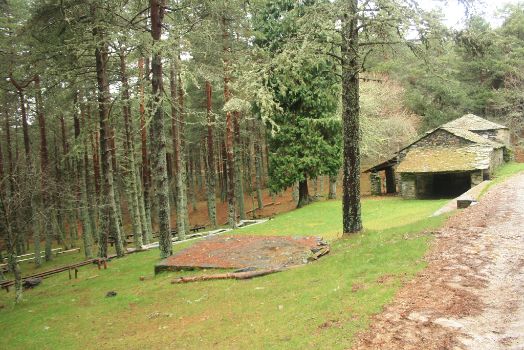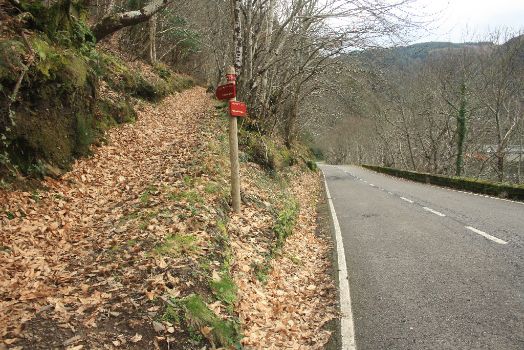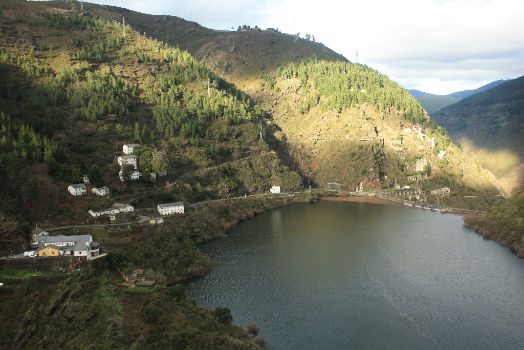Net of Natural
Trails

Stage 25: Berducedo - Grandas
Description
Along the Salime Reservoir
The Nature Trail wanders down to the Salime reservoir, through reforestation pines, skirting around Berducedo Ridge, included in the Sierras de Carondio and Valledor Protected Landscape, along a route with fantastic views of Grandas de Salime County and the villages that dot its valley, to arrive at Grandas, the capital.
The Nature Trail crosses from County Allande to Grandas de Salime, through vast plains carpeted with reforestation pines (Pinus sylvestris), although certain areas devastated by repeated fires have been covered by heath thickets. Meadows and farmland, dotted with "brañas" and small hamlets, make up the rest of the landscape. The final stretch runs through the hills around Salime reservoir, with fantastic views across the valley.

Two routes start at Berducedo. The main route skirts around Berducedo Ridge along the north (included in the Sierras de Carondio and Valledor Protected Landscape), descends to Salime Reservoir, and turns onto a path leading to Grandas. The alternative route also skirts around Berducedo Ridge, but along the south side, towards Villarpedre. It is possible to cross the reservoir by boat, then continue to Grandas on foot.
The main route starts in the centre of Berducedo. Immediately after leaving the parish church of Santa María to the right, there is a concrete track to the left. The 15th century church of Santa María de Berducedo, built in rustic style, was once a hospital for pilgrims. The church has a single rectangular nave, and a projecting portico on the front and south side. The façade is crowned with a three-arch belfry. To the right of the church is a beautiful yew.
Leaving the village behind, the Trail continues in a moderate climb through Berducedo Ridge to a downhill road, with fantastic views of County Grandas to the right. The route passes through the villages of La Mesa and, further on, is Buspol.
In Buspol, the route turns onto a dirt track that begins in the curve to the right. The Trail continues for a long time along this track, through pine forests, towards Salime Reservoir, until it finally comes upon the AS-14, which leads down to the reservoir.

The last stretch heads up the road, skirting the reservoir along the south side. After passing through a valley, the route reaches a signposted intersection, where it joins the alternative route from the south. Continuing along the main route, after the curve in the road, the Trail turns left and begins to climb up a small path leading to Grandas, the final destination of this section.
However, if the alternative route from Berducedo to River Oro is used, then, the Trail begins next to the start panel located in this village, and continues along the AS-34 to Villarpedre. The first stretch of this route is by road, past Berducedo recreation area, and then continues along a dirt track to the right, through a Scots pine forest.

The next section of the alternative route continues along this same dirt track, from where there are sweeping views of Sierra de Valledor and Alto de Valvaler (Allande), and the small villages scattered around the rivers Trabaces and Valledor. The route heads to the shrine of Bedramón, nestled amongst pine forests. The feast of Our Lady of Bedramón is commemorated here every August 15th. Past the shrine, the walk to Villarpedre continues for quite a while. After Villarpedre, the route heads to the reservoir, where it is possible to join the Nature Trail on the opposite side, crossing the reservoir by boat. The boat service is free and open from 9:30 AM to 6 PM. However, it is advisable to make an appointment with the service manager by calling +34 607 487 596. After crossing the reservoir by boat, the route continues along an uphill track with nice views of the deep Salime Valley with the backdrop of the reservoir. This track joins the main route shortly before reaching Grandas.
Sites of interest
Profile

Highlights
Further information
Sierras de Carondio and Valledor Protected Landscape
The Sierras de Carondio and Valledor Protected Landscape covers an area of 25,417 hectares that spans counties Allande, Grandas de Salime and Villayón. This protected nature area also includes the River Oro Site of Community Importance (SCI) and part of the Alcornocales del Navia SCI.
It is a hinterland mountain area, populated with shrubs, mainly heath, and the striking presence of the cork oak (Quercus suber). Located near Bojo is the largest cork oak forest in Asturias.
The mountains, dissected by the tributaries of the River Navia, are inhabited by wolves (Canis lupus signatus) and raptors, although the presence of bears (Ursus arctos) is not uncommon. Furthermore, this area abounds in otters(Lutra lutra).
Grandas
The capital of County Grandas sits on a small plateau above the Salime Reservoir, where the River Navia used to flow. A place for food and shelter on the original Way of St. James, Grandas, like Buspol, had a shelter for pilgrims.
Grandas' town centre is dominated by its parish church, the former medieval collegiate church of San Salvador. It is part of the historic centre where respect for traditional regional architecture, with slate roofs and walls, prevails. The extraordinary Romanesque façade is all that remains of the 12th century collegiate church of San Salvador, which has undergone successive alterations over the centuries. On the south side of the temple are two Romanesque-Gothic tombs. A tower, several chapels, the chapter and the sacristy were later added to the original structure. The first altarpieces were made between 1628 and 1634, and later painted by Pedro Díaz de Villabrille in 1641.
The Ethnographic Museum of Grandas de Salime is also housed in Grandas. The original driving force behind this initiative was Pepe el Ferreiro, a local scholar known to all neighbours, who began to collect unique pieces. Opened in 1986, the museum was first housed in the town council and later moved to the Rectory, a building erected in 1814, that has since been expanded many times. The Ethnographic Museum holds different collections of objects and tools related to rural life in western Asturias. It is spread over several spaces - the Rectory, the Courtyard, the Corridor, the Cabanón or Shed, the Miller's House, the Manor and outside the Museum. It reproduces various traditional ways of life, including a rural house, a cellar, a textile workshop, a canteen, a cobbler's workshop and an ironsmith's forge.





